
Welcome to Hyperion Records, a British classical label devoted to presenting high-quality recordings of music of all styles and from all periods from the twelfth century to the twenty-first.
Hyperion offers both CDs, and downloads in a number of formats. The site is also available in several languages.
Please use the dropdown buttons to set your preferred options, or use the checkbox to accept the defaults.

| The Tallis Scholars, Peter Phillips (conductor)» More |
The most likely explanation for this general descriptive title ‘brevis’ is that no other came readily to hand. In other cases of a ‘free’ setting, ‘Sine nomine’ was common; but some of these, like the one which has recently been proved to be based on Josquin’s motet Benedicta es, are bigger pieces in terms of the number of voices employed, and perhaps a distinction between the titles ‘Sine nomine’ and ‘Brevis’ is implied. Not that anyone ever proposed the title ‘Missa Longa’. The idea that the word ‘brevis’ comes from the fact that every movement starts with a breve in the original notation is discounted since literally hundreds of works start with this note-value and it is hard to imagine anyone fixing on this detail as being worthy of comment.
The music has a strong character, confidently written, with the motif of the falling minor third, usually followed by upward movement by step, appearing very regularly. This happens not only at the beginning of most movements, but frequently during them, for instance in the remarkable sequence in all the parts to the word ‘Amen’ in the Credo. This interval alone goes some way to explain the unusually subtle cohesion which the Missa Brevis displays on close acquaintance, where a casual glance might judge it to be disparate. The music is for SATB, increasing to SSATB for the beautiful second Agnus Dei. The phrase at the beginning of the first Agnus – an ascending scale – is inverted at the beginning of the second, which rounds off the music in the most satisfying way.
from notes by Peter Phillips © 1986
Le terme descriptif «brevis» fut très certainement employé par défaut, les mises en musique «libres» étant, autrement, qualifiées de «Sine nomine», bien que certaines, telle celle fondée (comme cela fut récemment établi) sur le motet josquinien Benedicta es, soient dévolues à un plus grand effectif vocal – d’où un distinguo entre les appellations «Sine nomine» et «Brevis». L’épithète «brevis» ne s’explique pas davantage par le fait que personne n’aurait jamais suggéré le titre «Missa Longa». Enfin, force est de rejeter l’idée selon laquelle cette épithète proviendrait de ce que chaque mouvement s’ouvre sur une brève, dans la notation originale, en tant que des centaines d’oeuvres commencent par cette valeur de note et que l’on n’imagine guère quelqu’un estimant que ce détail vaille d’être commenté.
La musique, au caractère affirmé, à l’écriture assurée, recourt au motif de la tierce mineure descendante, généralement suivie d’un mouvement ascendant par degrés conjoints, qui apparaît très régulièrement. Ce qui survient au début, mais aussi souvent au cours, de la plupart des mouvements – ainsi dans la remarquable séquence, à toutes les parties, au mot «Amen» du Credo. Cet intervalle explique à lui seul la cohésion étonnamment subtile que la Missa Brevis dévoile à qui la connaît bien, un coup d’oeil désinvolte pouvant, a contrario, la placer au rang des oeuvres disparates. La musique est écrite pour SATB, hormis le splendide second Agnus Dei, pour SSATB. La phrase d’ouverture du premier Agnus (une gamme ascendante) est inversée au début du second, qui clôt la pièce de la plus satisfaisante manière.
extrait des notes rédigées par Peter Phillips © 1986
Français: Gimell
Die einleuchtendste Erklärung für den allgemein gehaltenen, deskriptiven Titel „Brevis“ ist, dass sich ein anderer nicht ohne weiteres finden ließ. In anderen Fällen „freier“ Vertonungen war der Begriff „Sine nomine“ üblich; aber einige davon, wie z.B. diejenige, als deren Vorlage sich jüngst Josquins Motette Benedicta es erwiesen hat, bedienen sich einer größeren Anzahl von Stimmen, und möglicherweise ist eine diesbezügliche Unterscheidung zwischen „Sine nomine“ und „Brevis“ anzunehmen. Nicht, dass je irgendjemand den Titel „Missa Longa“ vorgeschlagen hätte. Die Vorstellung, das Wort „brevis“ könne von der Tatsache herrühren, dass jeder Satz in der Originalnotation mit einer Brevis, d.h. einer Doppelganzen beginnt, muss als abwegig gelten, da buchstäblich hunderte von Werken mit diesem Notenwert einsetzen und man sich kaum vorstellen kann, dass jemand dieses Detail als bemerkenswert hervorgehoben haben könnte.
Die Musik ist charaktervoll und selbstbewusst geführt, wobei mit großer Regelmäßigkeit das Motiv der absteigenden kleinen Terz auftaucht, der gewöhnlich eine stufenweise Aufwärtsbewegung folgt. Dies geschieht nicht nur am Anfang der meisten Sätze, sondern oft auch in deren Verlauf, beispielsweise in der bemerkenswerten Sequenz in allen Stimmen auf das Wort „Amen“ im Credo. Allein schon dieses Intervall trägt einiges dazu bei, den ungewöhnlich subtilen Zusammenhalt zu erklären, den die Missa Brevis bei näherer Bekanntschaft aufweist, während sie bei oberflächlicher Betrachtung als disparat gelten könnte. Die Musik ist für Sopran/Alt/Tenor/Bass gesetzt, verstärkt auf SSATB für das wunderschöne zweite Agnus Dei. Die Phrase zu Beginn des ersten Agnus – eine aufsteigende Tonleiter – wird zu Anfang des zweiten umgekehrt, was die Musik auf befriedigendste Weise abrundet.
aus dem Begleittext von Peter Phillips © 1986
Deutsch: Anne Steeb/Bernd Müller
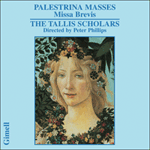 Palestrina: Missa brevis Palestrina: Missa brevisThis recording of Palestrina's Missa brevis is also available on our specially priced 2-CD set The Tallis Scholars sing Palestrina.» More |
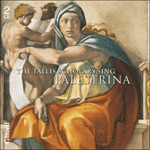 Palestrina: The Tallis Scholars sing Palestrina Palestrina: The Tallis Scholars sing Palestrina"Palestrina is probably the most talked-about composer in the history of classical music. Beethoven and Mozart are possible rivals in this, but with them the process hasn't been going on for so long. The Tallis Scholars have sung his music more th ...» More |
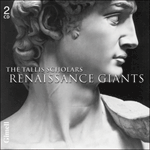 Renaissance Giants Renaissance Giants"The Renaissance is well known for its cultural giants. Leonardo da Vinci, Raphael, and above all Michelangelo epitomize a period when the human spirit seemed to grow and gain in confidence. This collection of complete works celebrates the musical ...» More |
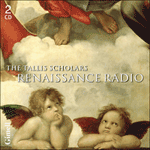 Renaissance Radio Renaissance RadioSacred Music from the Renaissance Era for Celestial and Secular Radio. When Peter Phillips founded The Tallis Scholars in 1973 sacred vocal music from the Renaissance Era was seldom heard on radio. Now it is firmly established as one of the great ...» More |
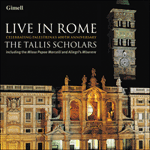 The Tallis Scholars Live in Rome The Tallis Scholars Live in RomePAL FORMAT DVD. Peter Phillips directs The Tallis Scholars in the historic concert celebrating Palestrina's 400th anniversary, filmed in the Roman Basilica of Santa Maria Maggiore where the composer sang as a choirboy and later became maestro di c ...» More |

